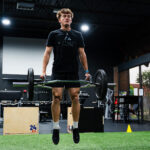Sports Training for Strength Gains in Youth Athletes
Strength is not just for adult athletes. In fact, sports training for strength is a crucial part of youth athletic development. With the right exercises, young athletes can build a solid foundation that improves performance, enhances coordination, and reduces injury risk.
Parents and coaches often ask, “Is strength training safe for kids?” The answer is yes—when it’s supervised, properly structured, and age-appropriate. In this article, we’ll explore how to approach strength training in youth sports, what exercises to include, and what to avoid.
Why Strength Matters in Youth Sports Training
Young athletes benefit greatly from developing strength. It’s not about building bulky muscles; it’s about developing control, power, and movement patterns.
Benefits include:
-
Improved coordination and balance
-
Reduced injury risk (especially knee and ankle injuries)
-
Increased muscle endurance
-
Enhanced performance in running, jumping, and changing direction
-
Better confidence and discipline
Strength also supports other elements of sports training such as agility, speed, and stability.
Is Strength Training Safe for Kids?
Yes—when done correctly. According to Healthline and pediatric sports medicine guidelines, strength training is safe for kids as young as 7 or 8 when:
-
Movements are taught and supervised by qualified coaches
-
Proper form is emphasized over heavy weight
-
Equipment is age-appropriate
-
Exercises focus on technique and control, not maximum lifting
Principles of Strength Training for Youth
When designing sports training for strength for younger athletes, follow these principles:
1. Prioritize Form Over Load
The most important rule in youth strength training is proper technique. A light load performed well is better than a heavy load performed poorly.
2. Focus on Bodyweight First
Before touching weights, young athletes should master their own body. Exercises like push-ups, squats, and planks build foundational strength.
3. Keep Sessions Short and Fun
Youth athletes have short attention spans. Training sessions should last no more than 30–45 minutes and should include engaging, varied movements.
4. Schedule 2–3 Times per Week
Strength gains happen with consistency. Two or three well-planned sessions each week are ideal for young athletes.
Best Strength Exercises for Youth Athletes
Here are the top bodyweight and resistance band exercises that support sports training for strength in youth athletes.
1. Air Squats
Muscles Worked: Quads, hamstrings, glutes
How to do it:
-
Stand with feet shoulder-width apart
-
Lower into a squat by bending the knees and hips
-
Keep chest up and knees behind toes
-
Return to standing
Reps: 2 sets of 10–15
2. Wall Sits
Purpose: Builds lower body endurance
How to do it:
-
Lean against a wall and slide down until knees are at 90 degrees
-
Hold the position for 20–30 seconds
-
Repeat 2–3 times
3. Push-Ups (Modified if Needed)
Muscles Worked: Chest, shoulders, triceps, core
How to do it:
-
Keep hands shoulder-width apart
-
Lower body until elbows are at 90 degrees
-
Push back to starting position
Modification: Do on knees if needed
Reps: 2 sets of 8–12
4. Glute Bridges
Purpose: Strengthens the posterior chain
How to do it:
-
Lie on your back with knees bent and feet flat
-
Lift hips off the ground by squeezing your glutes
-
Lower slowly and repeat
Reps: 2 sets of 10–15
5. Resistance Band Rows
Muscles Worked: Upper back, biceps
How to do it:
-
Anchor the band at chest height
-
Pull handles toward the chest, squeezing shoulder blades together
Reps: 2 sets of 10–12
Youth Strength Training Weekly Plan
Here’s a simple sample plan to build strength without overwhelming young athletes.
| Day | Focus Area | Exercises |
|---|---|---|
| Mon | Lower Body | Air squats, wall sits, glute bridges |
| Wed | Upper Body + Core | Push-ups, plank, resistance band rows |
| Fri | Total Body & Balance | Lunges, bear crawls, single-leg stance |
Make sure to include a 5–10 minute warm-up (jumping jacks, arm circles, high knees) and a cooldown (light stretching and breathing).
What to Avoid in Youth Strength Training
While strength training is safe, there are common mistakes to avoid in youth sports training:
-
Lifting heavy too early: Never max out with young athletes
-
Skipping warm-ups: Cold muscles are more prone to injury
-
Focusing only on weights: Bodyweight and resistance bands are usually enough
-
Ignoring rest: Kids need recovery just like adults
-
Lack of supervision: Always ensure a coach or adult is guiding the session
How Strength Training Improves Sports Performance
Whether your child plays basketball, soccer, or swims competitively, improved strength can lead to:
-
Quicker starts and faster sprints
-
Better jumping mechanics
-
More accurate throws and shots
-
Safer landings and change of direction
With the right training, young athletes feel stronger and more in control of their movements—skills that transfer directly to game performance.
For professional coaching that specializes in youth development, check out Next Level Athletics. Their programs are designed with long-term athlete growth in mind.
Conclusion: Start Early, Train Smart
Youth sports training for strength sets the stage for lifelong athletic performance. It’s not about heavy lifting—it’s about learning movement patterns, developing coordination, and preventing injuries. The earlier kids develop strength safely, the better their performance and health outcomes.
Keep it fun, stay consistent, and focus on long-term growth—not short-term gains.


Recent Comments